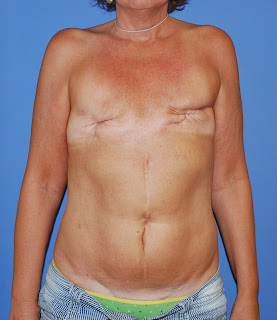So a little bit about my reconstruction options...
My options are
1) DIEP flap
Patients
typically ask in consultation what the recovery is like following DIEP or TRAM
Flap surgery. I find that patients may have some misconceptions regarding how
they are going to look and feel post-operatively. Typically at one week
post-operatively, most or all drains have been removed and steri-strips remain
in place on the breast reconstruction or on the abdomen. Bruising and swelling
often persist after the first week and being to improve over the next several
months up to one year.
Autologous reconstruction such as DIEP flaps are a
great alternative to implant based reconstruction if the patient has enough
tissue on their abdomen to donate to one or both reconstructed breasts. In
patients who have had repeated infections or capsular contracture with implants,
DIEP flaps represent a great method for reconstruction.
The above photograph, the patient is status post bilateral mastectomy.
The lower abdomen and perforators (blood supply) to carry the abdominal skin and fat from the abdomen to the chest wall is marked. The preferred vessels in the chest are the internal mammary vessels when available.
In the above photograph, the patient is one week post-operatively. All drains have been removed. Steri-strips remain in place for two weeks and are then discontinuesd. Bruising and swelling improve over the next several months to one year.
Breast reconstruction following mastectomy can be challenging for both the patient and surgeon. Breast reconstruction can be performed immediately following mastectomy or can be performed in a delayed fashion where a patient undergoes a mastectomy in one procedure and then implant or autologous tissue reconstruction in another procedure.
I typically educate patients who undergo reconstruction with tissue expanders or implants that these procedures are frequently performed in stages. Often, the first stage of reconstruction requires the placement of a tissue expander, followed by a second procedure where implants are placed and a final symmetry procedure is performed.
I have found great utility in the use of the neo-supracapsular pocket to control and reposition the inframammary fold in breast reconstruction. I find that the surgeon can have excellent control of the fold position without any untoward puckers or dimpling. One of the goals in breast reconstruction following mastectomy, is to have the patient feel comfortable and confident in clothing and/or in a bra.
1) What is autogenous breast reconstruction?
Autogenous breast reconstruction is the use of your own body's tissue to reconstruct the breast. This includes the TRAM (transverse rectus abdominus myocutaneous flap), gluteal flap (gluteus maximus myocutaneous flap), latissimus dorsi flap, DIEP (deep inferior epigastric perforator flap), SIEA (superficial inferior epigastric artery flap) and GAP (gluteal artery perforator flap) techniques.
..........................................................................................................................
2) What are the benefits of autogenous reconstruction versus implant reconstruction?
Since autogenous reconstruction uses your own body's tissue to reconstruct the breast, the tissue is there for life. You cannot reject it. It will change in volume as your normal weight fluctuations occur through life and often tends to improve in shape over time. The breast is reconstructed with fat, which is similar in density to breast tissue, thus the “feel” is similar to that of a normal breast.
Implant reconstructions tend to require multiple operations prior to achieving the final result. These could include sequential expansion of breast skin, repositioning of the implant, correction of infra-mammary fold distortion, correction of shape deformity, correction of implant extrusion, correction of implant leakage, correction of capsular contracture, removal of implant because of infection, replacement of temporary implant or expander with permanent implant. If a patient has had radiation or is planning to have radiation, implant reconstruction is discouraged because of the unacceptably high complication rate. The implants often require replacement. Implant manufacturers do not consider them “lifetime devices”. Their life expectancy is <10 years per manufacturer documentation. The occurrence of capsular contracture is often a concern with implant reconstructions. It is the result of your body's recognition of the implant as a foreign material. A capsule of scar is layed down around the prosthesis to as a barrier to contact with the body. The capsules vary in thickness and can sometimes calcify and become hard. As a result implant reconstructions tend to be more firm than a normal breast, thus feeling more artificial and remaining somewhat immobile to normal activity.
..........................................................................................................................
3) Are there any benefits of implant reconstruction over autogenous?
Implant reconstructions are typically shorter operations (1-2 hours) and do not prolong hospitalization. Autogenous reconstruction, specifically perforator flap reconstruction, typically takes 4-5 hours for a single reconstruction and 5-7 hours for a bilateral breast reconstruction. The hospital stay is 3-4 days for perforator flap reconstruction and may be slightly longer with TRAM flap procedures. Implant reconstructions also do not require a donor site and recovery is therefore usually shorter.
..........................................................................................................................
4) What is a DIEP flap?
DIEP stands for Deep Inferior Epigastric Perforator. This is the named vessel for which the tissue to be transferred is based. “Flap” is a plastic surgery term referring to the tissue which is to be transferred.
The deep inferior epigastric vessels arise from the external iliac vessels (the external iliac vessels become the femoral vessels in the leg). The deep inferior epigastric vessels course beneath the rectus abdominus (the major abdominal “six pack” muscle) on each side. These vessels send off branches to the muscle as well as through the muscle into the overlying fat. These perforating branches are those which are identified, preserved and transferred with the overlying tummy fat to reconstruct the breast.
Please comment your thoughts or what you would do





No comments:
Post a Comment